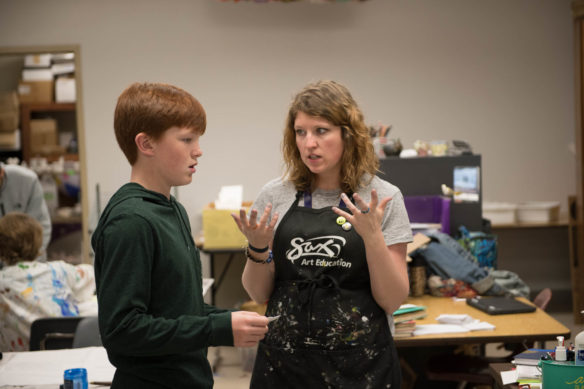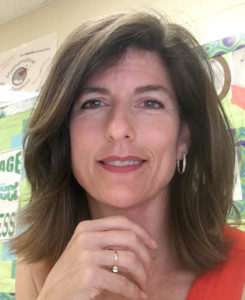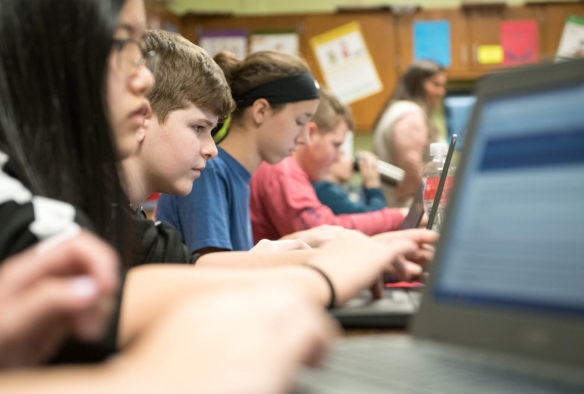
Kandice Kilcoyne, an art teacher at Drakes Creek Middle School (Warren County) and a mentor in the Academy at the Creek, talks with student Michael Lang. The Academy at the Creek is a daily period for the school’s gifted and talented students in which they work on problems and explore projects that pique their interest.
Photo by Bobby Ellis, April 25, 2018
By Mike Marsee
mike.marsee@education.ky.gov
Students in gifted and talented programs often look forward to that one day a week when they can expand their learning. At Drakes Creek Middle School, they don’t have to wait that long.
In the Academy at the Creek, about 75 gifted and talented students at the Warren County school get together during a daily class period to work with each other and mentors to explore projects that pique their interest.
Stacey Rose, a mathematics teacher who serves as the lead teacher for the academy and who has been involved since the program was created four years ago, said that daily engagement both in class and during lunch – the class falls during the lunch period – has been beneficial for students.

Stacey Rose
“The opportunities we have for in-depth discovery and discussion are greater with daily meeting,” Rose said. “Having the students together at this age is also a great way to create a supportive environment for gifted students. They get to know each other well working in various small groups throughout the year and eating lunch together.”
The Academy at the Creek was launched in 2014 to better serve gifted and talented students in the 7th and 8th grades, most of whom had participated in the 212° Academy, where gifted and talented 5th- and 6th-graders from the district’s elementary schools are brought one day a week.
“We were trying to figure out how we could as a school offer the same type of opportunities for our students without them leaving the building,” said Daryl Woods, the principal at Drakes Creek Middle. “We got with our advanced math and science teachers and said, ‘Can we pull this off?’ and we came up with a model
The format initially was centered on STEM (science, technology, engineering and mathematics), with the school’s advanced mathematics and science teachers leading the students. The program has evolved to focus on STEAM (those four disciplines plus the arts).
Woods said the class is both problem-based and project-based, and it plays out in three phases during the school year. Students first are guided by a teacher as they solve problems, then work in groups to examine different areas of study with mentors and finally devise and work on their own projects. Their work is featured in a year-end showcase, which is scheduled this year for May 29.
Kathie Anderson, the gifted and talented coordinator for the Kentucky Department of Education, said allowing students of similar abilities to work together serves them well.
“Pulling out gifted and talented students for a special class is one of several ways students can be served according to the regulations,” Anderson said. “When students of similar abilities work together, they find others who share their passion and peers who can motivate them to learn and explore. It is also a best practice for students to work and engage in real-world problems. Students interviewed say they enjoy working hands-on problems that are authentic and practical.”
At the Academy at Drakes Creek, none of that work is graded. Woods said it was Rose who suggested when the academy was formed that students shouldn’t have to worry about grades.
“She said, ‘If we give them grades, we’re not going to get what we want out of them,’” Woods said.
In other words, Rose said, high achievers who are also highly competitive might be more interested in protecting a high grade-point average than in taking a risk with a project that might not produce the outcome they desire or expect.
“A gifted child will often take the safer route if a grade is attached. They want to be sure to be right,” Rose said. “Without grades, they can be more free to choose an investigation that will end up in a problem that can’t be solved or a trail that shows no significant data.
“These ‘failures’ are a big part of learning. They have to enter the learning event to learn, not to produce a grade. That’s one thing we are after and one thing we continually evaluate – are the experiences motivating enough to draw the students’ interests and at a level that allows them to learn? We modify our plans every year and often within the year.”

Joshua Criswell, center, a 7th-grade student at Drakes Creek Middle School (Warren County), and other students work on creating a digital Breakout program during the Academy at the Creek. Students’ work in the academy is ungraded so they can be more free to take risks without fear of damaging their grade-point average.
Photo by Bobby Ellis, April 25, 2018
The academy’s students also have a substantial amount of input into their learning.
“It’s teacher facilitated and guided, but in this setting the students get to be copilots of their learning,” said Emily Duryea, the school’s gifted and talented coordinator. “You just see them work so much more diligently and invest so much more in a project when they decide the topic they want to explore.”
Rose said some of the students’ projects have been impressive. She said students have examined ways to reduce germs and infections, looked at an at-home cancer detection device, worked to determine whether food waste was sufficient to power a generator, tested how antioxidants can increase with a change in diet and tested the results of stress-relief activities. One of this year’s students is working on a plan to retrieve space junk that is orbiting the earth.
“Some of them are wanting to do humanitarian projects, such as bringing clean water to an inner city or a remote area. Some of them are wanting to work on health-related topics, such as ‘How can I reduce allergies?’ Several of them have done coding and tried to create apps. One student authored some short novels. They think big,” Woods said.
Duryea said that type of innovation is another byproduct of the students’ level of independence within the program.
“We think it’s imperative that gifted students have the opportunity to tackle different challenges or problems and explore their interest,” she said. “We’ve been able to see them involved in rich discussions in the classroom, and those extend to the lunch table.”
Woods said the school consulted with faculty members at Western Kentucky University’s Center for Gifted Studies on just how independent students could be, establishing some boundaries while still allowing a great deal of freedom.
Students also provide valuable feedback on their experiences in the academy. Rose said students fill out written reflections after their long-term projects are complete, and they fill out surveys twice a year.
“This helps us monitor the needs and wants of the large group,” she said. “This year we have included some social/emotional small discussion groups to help address some of the issues we were hearing from students.”
What Woods and those who work with the academy are hearing from parents is virtually all positive.
“In the past we’ve had some parents who were disappointed that their kids didn’t have opportunities, that didn’t feel like we were pushing them enough. I don’t know that we’ve had a complaint in the last two years,” he said.
“It seems like this kind of opportunity naturally attracts parental interest,” Duryea added. “I can recall at Christmas break the questions started rolling in: ‘What does it take for my child to participate next year?’”
Participation in the academy is growing, and Woods said he is pleased with how it has evolved and improved over the past four years.
“We’re proud of this, we’re proud that our kids have this opportunity and we’re proud that we’re serving gifted students’ needs, not just giving them lip service,” he said.
MORE INFO …
Kathie Anderson kathie.anderson@education.ky.gov
Emily Duryea emily.duryea@warren.kyschools.us
Stacey Rose stacey.rose@warren.kyschools.us
Daryl Woods daryl.woods@warren.kyschools.us






Leave A Comment